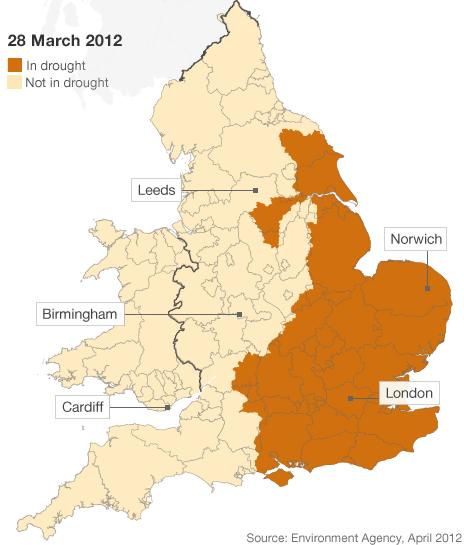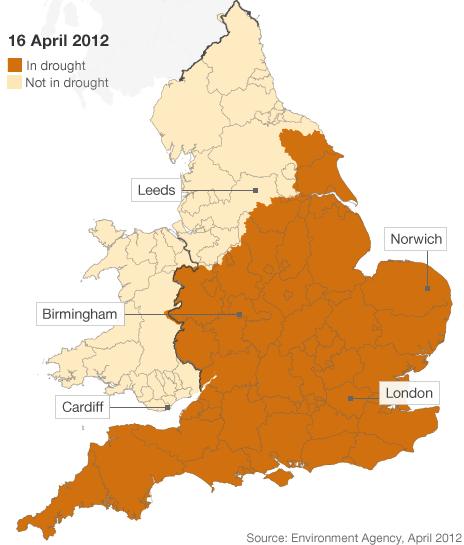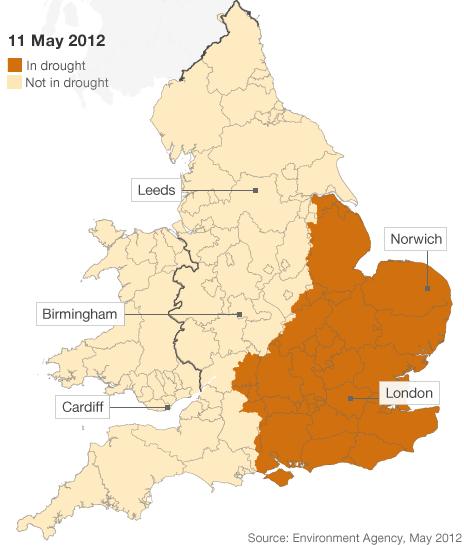Parts of England no longer in drought after heavy rain
- Published
The BBC's Jeremy Cooke says that rainfall next winter will be crucial
Parts of England are no longer in drought following heavy rain in recent weeks, the Environment Agency has said.
Drought status has been lifted in 19 areas of south-west England, the Midlands and parts of Yorkshire following persistent rainfall.
The Environment Agency's weekly drought update shows that last month was the the wettest April on record.
But eastern and south-east England remain in drought because groundwater levels remain low.
Drought status has been removed for South Yorkshire, East Yorkshire, Cornwall, Devon, Dorset, Somerset, Bristol, parts of Gloucestershire, parts of Hampshire, most of Wiltshire, Nottinghamshire, Leicestershire, Derbyshire, Staffordshire, West Midlands, Warwickshire, Shropshire, Worcestershire and Herefordshire.
How the drought spread





Following the review by the Environment Agency, parts of East Anglia - whose water is supplied by Cambridge Water, Essex and Suffolk Water and Veolia Water East - are also no longer considered to be in drought.
Under review
Hosepipe bans imposed by seven water companies on customers across south-eastern and eastern England remain in place and water restrictions are still in force in drought-affected regions.
However, England's biggest water company, Thames Water, said it would not need to apply for a Drought Order to further restrict water use.
But it warned that it was too early to lift the hosepipe ban imposed in April.
Richard Aylard, Thames Water's sustainability director, said: "Despite all the recent rain, we still have a serious groundwater shortage, and we could yet have a long, hot summer, so, much as we'd love to, it would be irresponsible for us to lift the hosepipe ban just yet."
The Environment Agency says it will continue to keep drought status under review and stressed that low groundwater levels remain a concern across England, with many as low as 1976 levels, when the country was gripped by a serious drought.
These are unlikely to return to normal levels before winter.
Environment Secretary Caroline Spelman said "A return to a long period of dry weather would increase the risk again."
About 50% of the public water supply in England is provided by groundwater sources - which are the areas facing temporary water restrictions.
If dry weather returns, this could lead to restrictions for farmers and environmental problems later in the year.
Until the beginning of April, England faced 18 months of very low rainfall which was the driest on record in some areas.
The Environment Agency's weekly water report for the week ending 11 May showed that many reservoirs are recovering but that groundwater sites remain extremely low in 42% of indicator sites across England.
This weekend is expected to be dry following heavy showers which brought flash flooding and rising river levels across the north of England.
Earlier this week, heavy rain across the country prompted a severe weather warning in parts of England and Wales.
While 19 serious flood alerts have been removed, flood warnings are still in place in certain parts of the North East and South West.
- Published11 May 2012
- Published5 April 2012
- Published16 April 2012
- Published16 April 2012